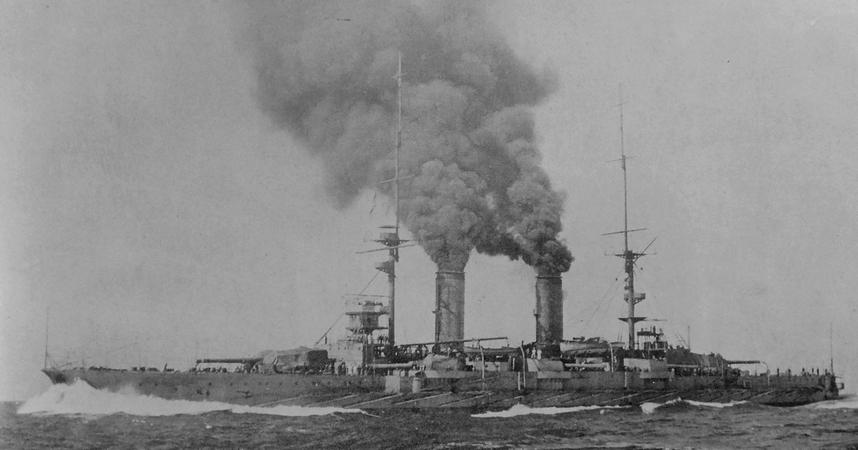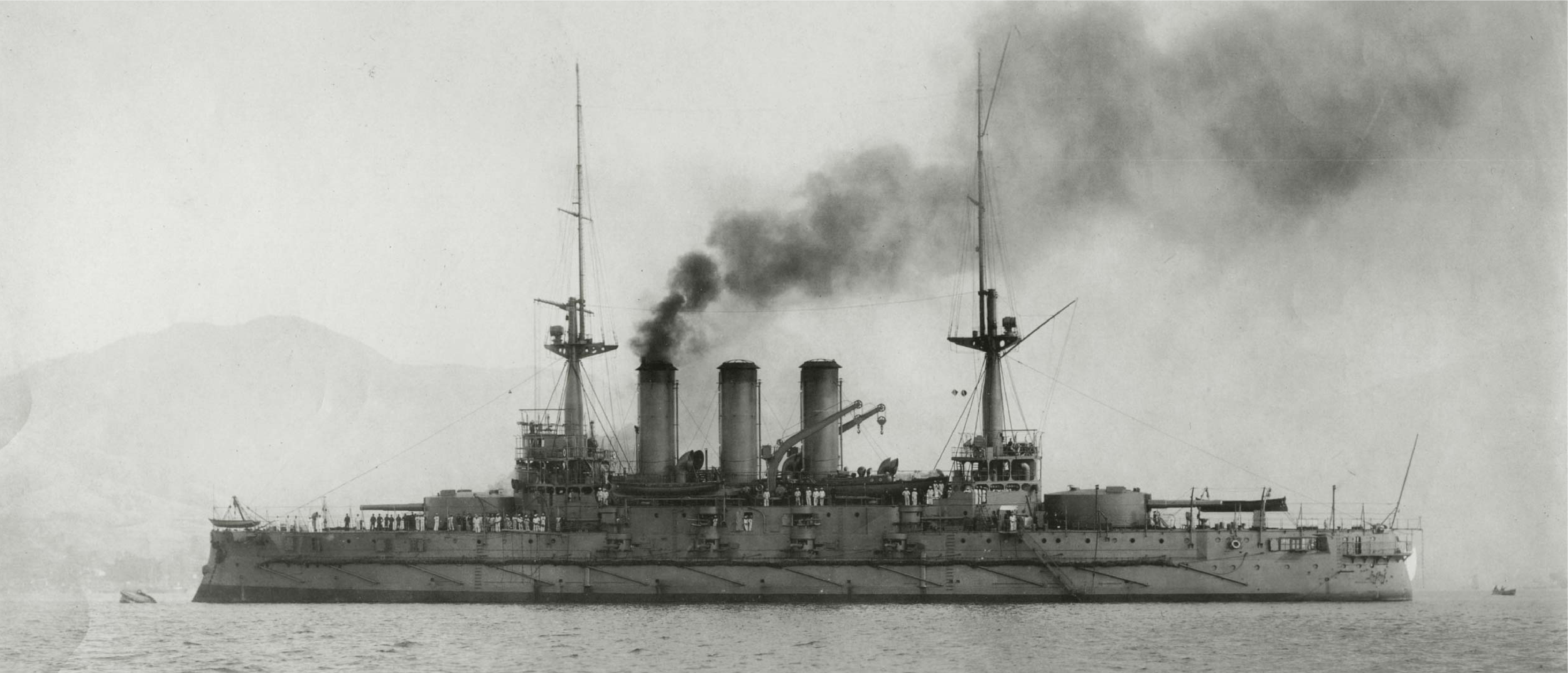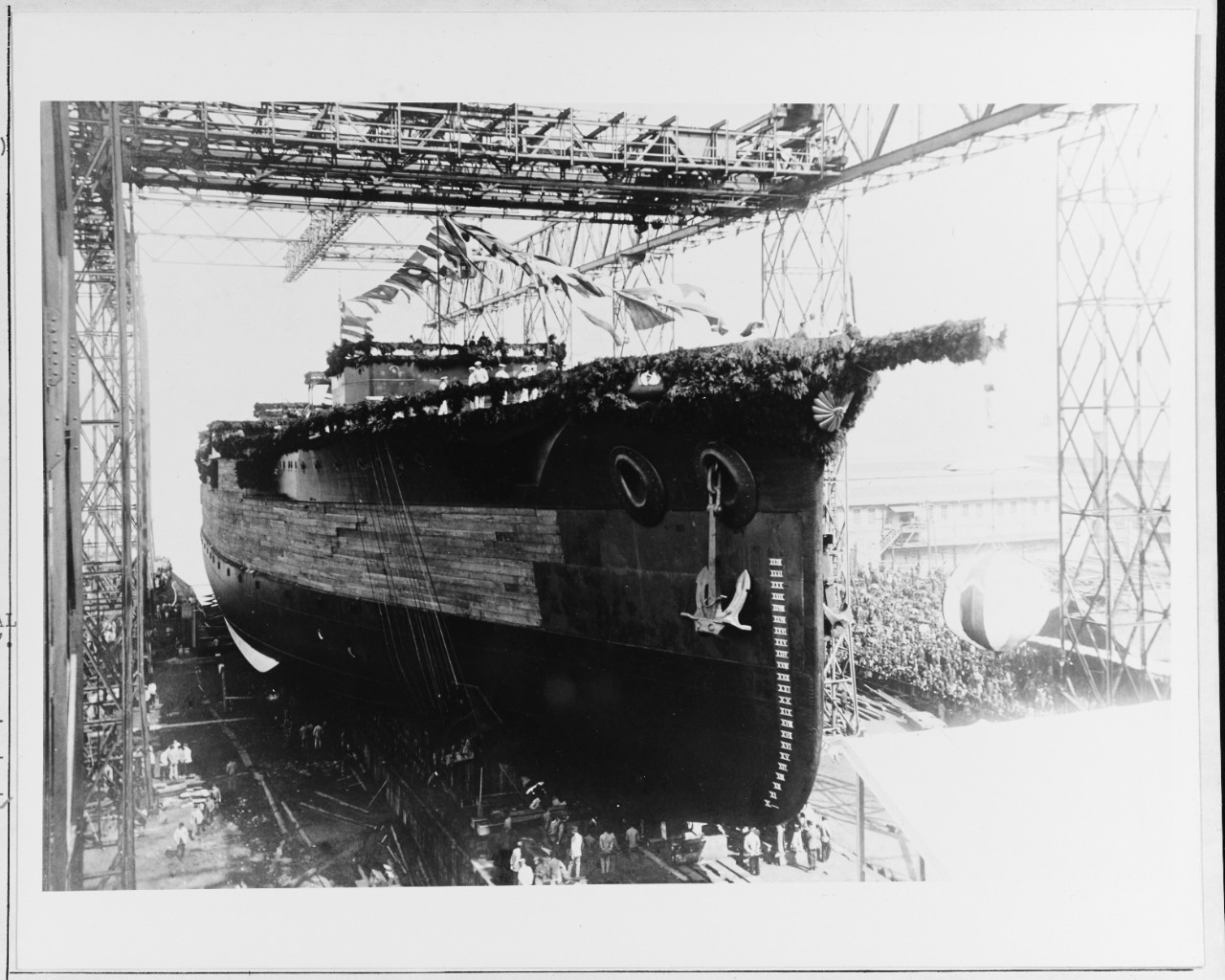| Rise of the Dragon:
Japan’s
Semi-Dreadnoughts
By Mike Bennighof, Ph.D.
October 2024
 Victory over Russia in 1905 brought the Japanese
Empire into the ranks of modern powers, the
only such nation outside the “white” world of Europe and North America. While the
alliance with Britain and the twin victories
of Tsushima and the Yellow Sea confirmed Japanese
power, they also meant that Japan had a new
status to defend. And after 1906, that status
was measured in the number of dreadnought
battleships a navy commanded. Victory over Russia in 1905 brought the Japanese
Empire into the ranks of modern powers, the
only such nation outside the “white” world of Europe and North America. While the
alliance with Britain and the twin victories
of Tsushima and the Yellow Sea confirmed Japanese
power, they also meant that Japan had a new
status to defend. And after 1906, that status
was measured in the number of dreadnought
battleships a navy commanded.
The Russo-Japanese War gave the Japanese
Navy some hard-won lessons and a great deal
of new material rapidly becoming obsolescent.
When war seemed imminent the Japanese quickly
bought two armored cruisers under construction
in Italy for Argentina. Two battleships were
under construction in Britain, and a war emergency
program authorized two more battleships, along
with a number of cruisers and a large selection
of light craft. And in the course of the war,
five Russian battleships — several of
them badly damaged — fell into Japanese
hands as well.
The two British-built ships, Kashima and Katori, arrived in June, 1906.
Their design was very similar to the contemporary
British King Edward VII class, but
with Armstrong 10-inch guns in their “corner” positions in place of the 9.2-inch in their
British near-sisters. Each carried a mixed
armament of four 12-inch guns, four 10-inch
guns and a dozen six-inch guns.

Satsuma making speed, and a great deal of smoke.
Training exercises showed that at longer
ranges, it became difficult to separate the
splashes of 12-inch and 10-inch shells. While
traditionalists continued to emphasize close
action in the Nelson fashion, others foresaw
that surface battles would be fought at the
ever-greater ranges permitted by modern guns
and optics. And eventually wartime experience
would show mixed armament to be a mistake
— big guns determined the outcome of
battleship actions, and the higher rate of
fire produced by smaller tubes did not compensate.
But even before the fighting commenced, the
Navy told its designers to come up with a
ship carrying a uniform armament of 12-inch
guns for the next generation of battleships.
The new class of two ships authorized in the
war emergency program would be built in Japanese
yards, though with considerable material imported
from British and American manufacturers (over
60 percent of the total). The initial design
called for eight 12-inch guns in four twin
turrets, arranged in pairs fore-and-aft but
on the same deck level. That prevented the
second turret in each pair from firing directly
ahead or astern.
Japanese thought had been merging the roles
of the battleship and the armored cruiser,
and this design reflected that trend. She
had belt armor of only seven inches, the same
as the armored cruiser Tsukuba then
also being designed as part of the same program. Tsukuba was also a hybrid design, with
a battleship's main armament (four 12-inch
guns) and a cruiser's speed and protection.
The new battleship design needed to be substantially
better protected than an armored cruiser,
and the Navy rejected the proposal.
Now facing hard deadlines, the designers
drafted a ship based on an enlarged Tsukuba with heavier armament and better protection.
In profile she looked very much like the cruiser,
with a flush deck where Tsukuba’s was
broken. She would have a dozen 12-inch guns,
with twin turrets four and aft and in each
“wing” position, and single turrets
at the "corners." The Navy accepted
the design and placed their orders, making
Japan the first nation to order a dreadnought-type
battleship.

Both ships would be built at Japanese Naval
Yards. Satsuma was laid down at Yokosuka
in May 1905, two weeks before the climactic
Battle of Tsushima and five months before
Britain's Dreadnought. Wartime delays
had kept Tsukuba on the slipway at
Kure, and the second battleship, Aki,
could not be laid down until the cruiser had
been launched. Construction finally commenced
in April 1906.
Daily Content includes no AI-generated content or third-party ads. We work hard to keep it that way, and that’s a lot of work. You can help us keep things that way with your gift through this link right here.
Problems cropped up almost immediately.
The delays in starting Aki caused the
inevitable tinkering — both the Navy
and her designers sought to make improvements
while they waited for the slipway to clear.
The Navy wanted to test turbine propulsion
in a large warship, and ordered a set from
Curtiss in the United States. The design team
upgraded the secondary armament from the dozen
4.7-inch guns in Satsuma to eight 6-inch
guns for Aki. Because of the change
in machinery, Aki had three funnels
where her sister had two.
Japan could not yet produce heavy naval
guns, and while the sisters had been designed
and laid down, Britain started a naval revolution
with the launch of HMS Dreadnought in February 1906 and by laying down the equally
innovative battle cruiser Inflexible a month
later. Three sisters followed Dreadnought within a year, and two more battle cruisers.
For the previous decade, a typical British
class of four battleships would have required
sixteen 12-inch guns. Dreadnought alone
carried 10. The armored cruisers that preceded
the new battle cruisers carried no big guns;
each of the new ships had eight. Suddenly
the Royal Navy's purchase of 12-inch guns
for its naval building program leapt fourfold,
from 16 to 64. And Brazil had already placed
orders for three battleships requiring another
36 big guns.
Only two private firms manufactured heavy
guns in Britain, Armstrong's and Vickers.
They had been colluding for years to obtain
foreign contracts and now used their duopoly
to force prices to skyrocket. Armstrong’s
may also have carried a grudge against the
Japanese for building their new ships in their
own yards after a long run of orders from
the firm's shipbuilding division.

The rebuilt battleship Hizen, the former Russian Retvizan.
For reasons of graft and prestige, the Imperial
Navy had already committed huge sums to rebuilding
the captured Russian battleships. These five
ships doubled the Japanese battle line, but
were by no means modern fighting units and
would soon be rendered totally obsolescent.
The government considered it a very telling
sign to have the former Russian ships under
the Japanese flag, and pressed the Navy to give the
project priority. All the Russian ships would
receive the new Japanese-designed and -built
Miyabara boiler system, and the order represented
a massive cash influx to the new industry.
Too many jobs, and too much profit, rested
on the rebuilding project.
All the ex-Russian ships required new main
armament, totalling twenty 12-inch guns. Facing financial
ruin after their war with Russia, and with
the Americans demanding cash up front for Aki's machinery, the Japanese could
not afford forty-four 12-inch guns —
24 for their two new battleships and 20 more
for the Russian prizes.
But Armstrong’s offered a compromise solution.
The firm had begun turning out a large number
of 10-inch guns on the basis of an order from
Brazil for three small battleships each carrying
a dozen of the weapons. And when Sir John
Fisher was elevated to First Lord of the Admiralty,
they believed that his enthusiasm for the
10-inch gun’s rapid fire would lead to its
adoption in the new generation of battleships.
That didn’t happen, and the cannon foundry was left with a large number of guns
without a customer, and offered them to the
Japanese at a bargain price.
Grudgingly, the Japanese accepted. They
assigned the 12-inch guns they did manage
to buy to the ex-Russian ships, and re-cast
the design of Satsuma and Aki around the 10-inch guns. The corner and wing
turrets would each be replaced with a twin
10-inch turret, giving each ship a battery
of four 12-inch guns and a dozen 10-inch guns.
This added more construction delays to the
two “semi-dreadnoughts,” and they
had been surpassed by most other nations when
they entered service, Satsuma in March 1910
and Aki a full year later.

Aki under construction.
Aki turned out to be almost two knots faster
than her sister, proving turbine technology
to the Imperial Navy. But neither ship was
very satisfactory, outdated even as they made
their first cruises. They saw very little
service during the First World War, cruising
offshore during the deployment to capture
Tsingtao from the Germans. Satsuma went to Rabaul in October 1914 as flagship
of the Second South Sea Squadron assembled
to search for the German East Asia Cruiser
Squadron but no action resulted.
The Japanese faced impossible choices: to
maintain their status, they had to build impressive
new warships, but the war that brought them
this status had also destroyed their finances.
The British move to all-big-gun ships could
not have come at a worse time for Japan, but
it was inevitable. As anyone who has run a game
company knows, circumstances beyond one's
control often seem to conspire to strike at
the worst possible time, and so it was for
the Japanese and their two semi-dreadnoughts.
By compromising and spreading the big guns
over the Russian prizes and the new ships,
the Imperial Navy ended up with seven ships
of limited fighting power instead of two good
ones and five piles of scrap steel. The money
spent at a time when Japan could not afford
it turned out to be largely wasted. Both semi-dreadnoughts
remained in service through the First World
War and were used as targets in 1924 —
officially to meet the requirements of the
Washington Naval Treaty, but they had been
written off in practical terms years before.
You can order Rise of the Dragon (second edition) right here.
Prince Chun’s Dreadnoughts
Russo-Japanese War (Playbook)
Rise of the Dragon (2e)
Retail Price: $99.98
Package Price: $80.00
Gold Club Price: $64.00
You can order Prince Chun right here.
Sign up for our newsletter right here. Your info will never be sold or transferred; we'll just use it to update you on new games and new offers.
Mike Bennighof is president of Avalanche Press and holds a doctorate in history from Emory University. A Fulbright Scholar and NASA Journalist in Space finalist, he has published a great many books, games and articles on historical subjects; people are saying that some of them are actually good.
He lives in Birmingham, Alabama with his wife, three children, and his new puppy. His Iron Dog, Leopold, could swim very well.
Daily Content includes no AI-generated content or third-party ads. We work hard to keep it that way, and that’s a lot of work. You can help us keep things that way with your gift through this link right here.
|
